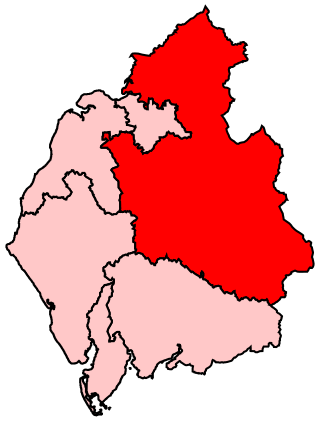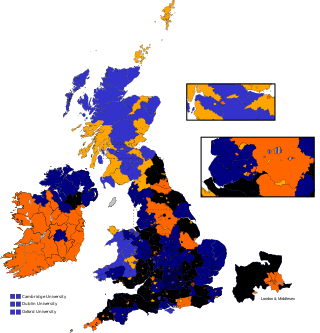Related Research Articles

Workington was a constituency in Cumbria represented in the House of Commons of the UK Parliament.

Penrith and The Border was a constituency in Cumbria represented in the House of Commons of the UK Parliament. It elected only members of the Conservative Party since its creation in 1950.
East Grinstead was a parliamentary constituency in the Kingdom of England, the Kingdom of Great Britain, and the United Kingdom. It first existed as a Parliamentary borough from 1307, returning two Members of Parliament to the House of Commons elected by the bloc vote system. The borough was disfranchised under the Reform Act 1832, but the name was revived at the 1885 election when the Redistribution of Seats Act created a new single-member county division of the same name.
Epping was a parliamentary constituency represented in the House of Commons of the UK Parliament from 1885 to 1974. It elected one Member of Parliament (MP) by the first past the post system of election.

Crewe was a constituency of the House of Commons of the Parliament of the United Kingdom from 1885 to 1983. It elected one Member of Parliament (MP) by the first past the post system of election.

Oswestry was a United Kingdom Parliamentary constituency. It was a constituency of the House of Commons of the Parliament of the United Kingdom from 1885 to 1983, when it was renamed North Shropshire. It elected one Member of Parliament (MP) by the first past the post method of election.

Camborne was a county constituency in Cornwall which returned one Member of Parliament to the House of Commons of the Parliament of the United Kingdom. It was created for the 1885 general election, and abolished for the 1950 general election, when it was largely replaced by the new Falmouth and Camborne.

Westmorland was a constituency covering the county of Westmorland in the North of England, which returned Members of Parliament to the House of Commons of the Parliament of the United Kingdom.
Howdenshire was a county constituency in Yorkshire which returned one Member of Parliament (MP) to the House of Commons of the Parliament of the United Kingdom, elected by the first past the post voting system.

Skipton was a county constituency centred on the town of Skipton in Yorkshire which returned one Member of Parliament (MP) to the House of Commons of the Parliament of the United Kingdom.

Cleveland was a county constituency in the Langbaurgh Wapentake, North Riding of Yorkshire, England.
Thornbury was a county constituency centred on the town of Thornbury in Gloucestershire. It returned one Member of Parliament (MP) to the House of Commons of the Parliament of the United Kingdom, elected by the first past the post voting system.

Rutland and Stamford is a county constituency comprising the area centred on the town of Stamford in Lincolnshire, the county of Rutland and also parts of rural Leicestershire making it a very unusual parliamentary constituency as it spans three counties. It returns one Member of Parliament (MP) to the House of Commons of the Parliament of the United Kingdom, using the first-past-the-post voting system.
North Cumberland was a parliamentary constituency in Cumberland which returned one Member of Parliament (MP) to the House of Commons of the Parliament of the United Kingdom, elected by the first past the post system of election.
Egremont was a parliamentary constituency centred on the town of Egremont in Cumberland. It returned one Member of Parliament (MP) to the House of Commons of the Parliament of the United Kingdom, elected by the first past the post system.

West Cumberland was a county constituency in the House of Commons of the Parliament of the United Kingdom. It elected two Members of Parliament (MPs) by the bloc vote system of election.
Pudsey and Otley was a parliamentary constituency centred on the towns of Pudsey and Otley in West Yorkshire. It returned one Member of Parliament (MP) to the House of Commons of the Parliament of the United Kingdom, elected by the first past the post system.
Rothwell was a parliamentary constituency centred on the Rothwell area of West Yorkshire. It returned one Member of Parliament (MP) to the House of Commons of the Parliament of the United Kingdom, elected by the first past the post system.
Cockermouth was the name of a constituency of the House of Commons of the Parliament of England in 1295, and again from 1641, then of the Parliament of Great Britain from 1707 to 1800 and of the Parliament of the United Kingdom from 1801 to 1918. It was a parliamentary borough represented by two Members of Parliament until 1868, and by one member from 1868 to 1885. The name was then transferred to a county constituency electing one MP from 1885 until 1918.
The 1921 Penrith and Cockermouth by-election was a parliamentary by-election held for the British House of Commons constituency of Penrith and Cockermouth in Cumberland on 13 May 1921.
References
- ↑ Yorkshire Post and Leeds Intelligencer, 23 Mar 1936
Craig, F. W. S. (1983). British parliamentary election results 1918-1949 (3 ed.). Chichester: Parliamentary Research Services. ISBN 0-900178-06-X.